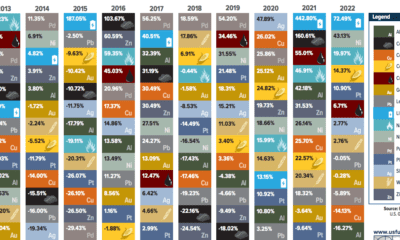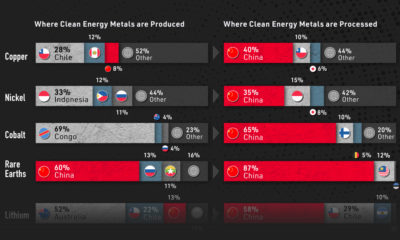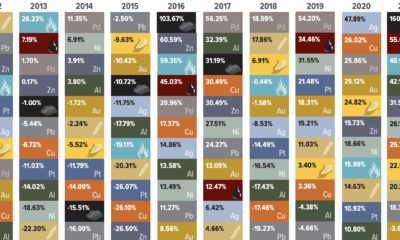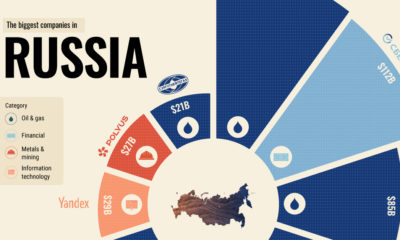The Story of Voisey’s Bay: The Auction (Part 2 of 3)
Presented by: Equitas Resources, “Nickel exploration in Labrador”
Preface
The hit at diamond drill hole #2 of 33m of massive sulphides turned Voisey’s Bay from caribou pasture to one of the most exciting stories in the mining world. For a full recap of the events leading to this point, check out Part 1 of the Voisey’s Bay story. In Part 2 of this series, we look at the ensuing bidding war that occurred once it was clear that Voisey’s Bay had all of the action. Again, we have turned to Jacquie McNish’s fabulous book The Big Score, which documents the history of the discovery, biographical elements of Robert Friedland’s life, and the ensuing bidding war between Inco and Falconbridge that led to one of the most spectacular takeovers in mining history. If you like these infographics, then look into buying Jacquie’s book. It was gripping and full of information.
Setting the Stage
The discovery of massive sulphides with Hole #2 brought increased attention to the former diamond play. However, the stock price didn’t really explode until the assays came in: 2.23% nickel, 1.47% copper, and 0.123% cobalt. Diamond Fields now traded in December 1994 at $13.50 per share, up from $4.65 just a month prior. The company doubled down on drilling, and up until January 1995 they had hit nothing after Hole #2. The price dribbled down to $11.00. However, it was in February 1995 that the results for Holes #7 and #8 were released, and they were some of the most significant holes for the entire project. The holes were in the Ovoid, which would soon be a famed and ultra-high rich section of the Voisey’s Bay discovery. Hole #7 was 104m long and had 3.9% nickel, 2.8% copper, and 0.14% cobalt. Hole #8 was 111m long and had 3.7% nickel, 2.78% copper, and 0.13% cobalt. This propelled the stock price to $20.00 in February 1995. Continued exploration of the Ovoid revealed a bowl-shaped orebody lying just below surface. This deposit had surface dimensions of some 800m by 350m, and extended to depths of about 125m. More nickel from Ovoid came in every month, and the stock price continued to rise. At this point, Diamond Fields could no longer fly under the radar. Major mining couldn’t stand to watch as one of the world’s greatest base metal deposits blossomed outside of their influence.
The Suitors
Three major mining companies vied to get in on the action. Here’s some history on each of them: Teck At this time, the Canadian diversified mining company Teck had nine mines in operation and had a reputation as a swift deal maker.
In 1947, Teck’s founder Norman Keevil Sr. was one of the first to use magnetic survey technology that was first employed by the US Military to find submarines. With this technology, he found one of the richest copper deposits in Canada. He once impressed a plane load of investors by flying them over a 150-foot copper vein that was exposed to the air. It shone like a newly minted penny as they passed over, stunning even the most skeptical investors. (He had previously parachuted a crew in to polish the ore in the bush.)
Inco The International Nickel Company was founded in 1902 and for most of the 20th century it remained the dominant player in nickel exploration, production, and marketing. The company virtually invented the nickel market:
In 1890, global output of nickel was 3,000 tonnes Nickel was mainly used for military purposes but sales dried up at the end of WWI The company discovered nickel alloys that were marketed for use in automobiles, pipes, industry, coins, and even kitchen sinks By 1951, the world consumed 130,000 tonnes of nickel a year with 90% of it supplied by Inco
By 1995, Inco was still the market leader in nickel, producing 26% of the world’s nickel with $2.3 billion in sales each year. Falconbridge In 1901, American inventor Thomas Edison found a nickel-copper ore body in the area northeast of Sudbury, Ontario. However, it wasn’t until 1928 that Thayer Lindsley, the founder of Falconbridge, bought these claims and began to turn it into its first mine. At the time, Inco had the only technology in North America to refine nickel, so Falconbridge sent its production to Norway where it purchased an operating refinery. The company was smaller than Inco, but seen as more aggressive and nimble. The company produced 11% of the world’s nickel in 1995.
The Bidding Begins
While Inco, Falconbridge and up to a dozen other global miners spent resources on calculating the value of Voisey’s Bay, Teck was the first to approach with a different strategy. In less than a day, and despite seeing any core, Teck was able to do a simple deal less than four pages long: $108 million for 10% of the company, or the equivalent of $36 per share. Teck also surrendered their voting rights to Friedland to prevent future hostile takeovers. That got the market talking. Days later, the stock would trade at over $40 per share with a market capitalization of more than $1 billion. In May 1995, after much posturing between Inco and Diamond Fields executives, another deal was struck. This time, Inco bought a 25% stake of Voisey’s Bay for US$386.7 million in preferred shares and cash, as well as 8% of Diamond Fields from company co-founder Jean-Raymond Boulle and early investor Robertson Stephens. By the time the deal closed in June 1995, Diamond Fields’ stock price doubled again to $80.00. After months of drilling misses outside of the Ovoid, finally in August there were signs of light: 1m of massive sulphides were hit on Hole #166. In November, drill hole #202 retrieved 40m of massive sulfides, the largest section of sulfides found outside the Ovoid. It was now clear that there was a series of deposits at Voisey’s Bay. The hole assayed 3.36% nickel and became a part of what is known as the Eastern Deeps.
The Showdown
In December, Inco and Falconbridge both began to aggressively pursue Diamond Fields. First, Inco presented a deal in principle for $3.5 billion, or $31 per share. Then, Falconbridge intercepted with an official offer for $4.0 billion, or $36 per share. This was a risky move for the smaller company, but it limited its downside by adding in $100 million in fees to the agreement in the case the deal were to not be finalized. Next, the two competitors (Inco and Falconbridge) teamed together through a mutual connection to present an offer in tandem. It was instantly shot down by Friedland. Finally on March 26th 1996, Inco announced a takeover bid of its own for $4.5 billion of Diamond Fields – the equivalent of $43.50 per share or $174 pre-split. Inco’s stock price dropped but it held on, making the total value of the deal closer to $4.3 billion. On April 3, the deal was officially signed by all parties. Part 3: Voisey’s Bay Today
on Did you know that nearly one-fifth of all the gold ever mined is held by central banks? Besides investors and jewelry consumers, central banks are a major source of gold demand. In fact, in 2022, central banks snapped up gold at the fastest pace since 1967. However, the record gold purchases of 2022 are in stark contrast to the 1990s and early 2000s, when central banks were net sellers of gold. The above infographic uses data from the World Gold Council to show 30 years of central bank gold demand, highlighting how official attitudes toward gold have changed in the last 30 years.
Why Do Central Banks Buy Gold?
Gold plays an important role in the financial reserves of numerous nations. Here are three of the reasons why central banks hold gold:
Balancing foreign exchange reserves Central banks have long held gold as part of their reserves to manage risk from currency holdings and to promote stability during economic turmoil. Hedging against fiat currencies Gold offers a hedge against the eroding purchasing power of currencies (mainly the U.S. dollar) due to inflation. Diversifying portfolios Gold has an inverse correlation with the U.S. dollar. When the dollar falls in value, gold prices tend to rise, protecting central banks from volatility. The Switch from Selling to Buying In the 1990s and early 2000s, central banks were net sellers of gold. There were several reasons behind the selling, including good macroeconomic conditions and a downward trend in gold prices. Due to strong economic growth, gold’s safe-haven properties were less valuable, and low returns made it unattractive as an investment. Central bank attitudes toward gold started changing following the 1997 Asian financial crisis and then later, the 2007–08 financial crisis. Since 2010, central banks have been net buyers of gold on an annual basis. Here’s a look at the 10 largest official buyers of gold from the end of 1999 to end of 2021: Rank CountryAmount of Gold Bought (tonnes)% of All Buying #1🇷🇺 Russia 1,88828% #2🇨🇳 China 1,55223% #3🇹🇷 Türkiye 5418% #4🇮🇳 India 3956% #5🇰🇿 Kazakhstan 3455% #6🇺🇿 Uzbekistan 3115% #7🇸🇦 Saudi Arabia 1803% #8🇹🇭 Thailand 1682% #9🇵🇱 Poland1282% #10🇲🇽 Mexico 1152% Total5,62384% Source: IMF The top 10 official buyers of gold between end-1999 and end-2021 represent 84% of all the gold bought by central banks during this period. Russia and China—arguably the United States’ top geopolitical rivals—have been the largest gold buyers over the last two decades. Russia, in particular, accelerated its gold purchases after being hit by Western sanctions following its annexation of Crimea in 2014. Interestingly, the majority of nations on the above list are emerging economies. These countries have likely been stockpiling gold to hedge against financial and geopolitical risks affecting currencies, primarily the U.S. dollar. Meanwhile, European nations including Switzerland, France, Netherlands, and the UK were the largest sellers of gold between 1999 and 2021, under the Central Bank Gold Agreement (CBGA) framework. Which Central Banks Bought Gold in 2022? In 2022, central banks bought a record 1,136 tonnes of gold, worth around $70 billion. Country2022 Gold Purchases (tonnes)% of Total 🇹🇷 Türkiye14813% 🇨🇳 China 625% 🇪🇬 Egypt 474% 🇶🇦 Qatar333% 🇮🇶 Iraq 343% 🇮🇳 India 333% 🇦🇪 UAE 252% 🇰🇬 Kyrgyzstan 61% 🇹🇯 Tajikistan 40.4% 🇪🇨 Ecuador 30.3% 🌍 Unreported 74165% Total1,136100% Türkiye, experiencing 86% year-over-year inflation as of October 2022, was the largest buyer, adding 148 tonnes to its reserves. China continued its gold-buying spree with 62 tonnes added in the months of November and December, amid rising geopolitical tensions with the United States. Overall, emerging markets continued the trend that started in the 2000s, accounting for the bulk of gold purchases. Meanwhile, a significant two-thirds, or 741 tonnes of official gold purchases were unreported in 2022. According to analysts, unreported gold purchases are likely to have come from countries like China and Russia, who are looking to de-dollarize global trade to circumvent Western sanctions.
There were several reasons behind the selling, including good macroeconomic conditions and a downward trend in gold prices. Due to strong economic growth, gold’s safe-haven properties were less valuable, and low returns made it unattractive as an investment.
Central bank attitudes toward gold started changing following the 1997 Asian financial crisis and then later, the 2007–08 financial crisis. Since 2010, central banks have been net buyers of gold on an annual basis.
Here’s a look at the 10 largest official buyers of gold from the end of 1999 to end of 2021:
Source: IMF
The top 10 official buyers of gold between end-1999 and end-2021 represent 84% of all the gold bought by central banks during this period.
Russia and China—arguably the United States’ top geopolitical rivals—have been the largest gold buyers over the last two decades. Russia, in particular, accelerated its gold purchases after being hit by Western sanctions following its annexation of Crimea in 2014.
Interestingly, the majority of nations on the above list are emerging economies. These countries have likely been stockpiling gold to hedge against financial and geopolitical risks affecting currencies, primarily the U.S. dollar.
Meanwhile, European nations including Switzerland, France, Netherlands, and the UK were the largest sellers of gold between 1999 and 2021, under the Central Bank Gold Agreement (CBGA) framework.
Which Central Banks Bought Gold in 2022?
In 2022, central banks bought a record 1,136 tonnes of gold, worth around $70 billion. Türkiye, experiencing 86% year-over-year inflation as of October 2022, was the largest buyer, adding 148 tonnes to its reserves. China continued its gold-buying spree with 62 tonnes added in the months of November and December, amid rising geopolitical tensions with the United States. Overall, emerging markets continued the trend that started in the 2000s, accounting for the bulk of gold purchases. Meanwhile, a significant two-thirds, or 741 tonnes of official gold purchases were unreported in 2022. According to analysts, unreported gold purchases are likely to have come from countries like China and Russia, who are looking to de-dollarize global trade to circumvent Western sanctions.



















